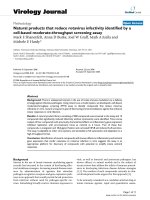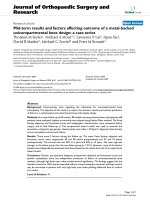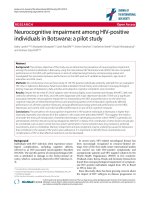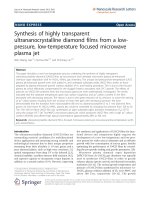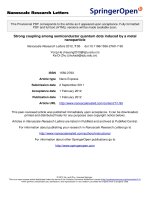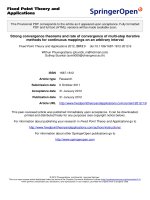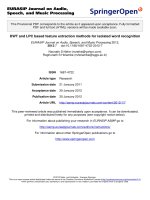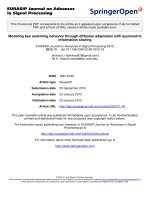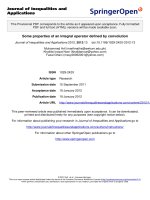Báo cáo toán học: " Strong coupling among semiconductor quantum dots induced by a metal nanoparticle" ppt
Bạn đang xem bản rút gọn của tài liệu. Xem và tải ngay bản đầy đủ của tài liệu tại đây (1.5 MB, 19 trang )
This Provisional PDF corresponds to the article as it appeared upon acceptance. Fully formatted
PDF and full text (HTML) versions will be made available soon.
Strong coupling among semiconductor quantum dots induced by a metal
nanoparticle
Nanoscale Research Letters 2012, 7:95 doi:10.1186/1556-276X-7-95
Yong He ()
Ka-Di Zhu ()
ISSN 1556-276X
Article type Nano Express
Submission date 2 September 2011
Acceptance date 1 February 2012
Publication date 1 February 2012
Article URL />This peer-reviewed article was published immediately upon acceptance. It can be downloaded,
printed and distributed freely for any purposes (see copyright notice below).
Articles in Nanoscale Research Letters are listed in PubMed and archived at PubMed Central.
For information about publishing your research in Nanoscale Research Letters go to
/>For information about other SpringerOpen publications go to
Nanoscale Research Letters
© 2012 He and Zhu ; licensee Springer.
This is an open access article distributed under the terms of the Creative Commons Attribution License ( />which permits unrestricted use, distribution, and reproduction in any medium, provided the original work is properly cited.
Strong coupling among semiconductor quantum dots in-
duced by a metal nanoparticle
Yong He and Ka-Di Zhu
∗
Key Laboratory of Artificial Structures and Quantum Control (Ministry of Education), Department of Physics,
Shanghai Jiao Tong University, 800 DongChuan Road, Shanghai 200240, China
Email:
*
Corresponding author:
Abstract
Based on cavity quantum electrodynamics (QED), we investigate the light-matter interaction between surface
plasmon polaritons (SPP) in a metal nanoparticle (MNP) and the excitons in semiconductor quantum dots (SQDs)
in an SQD-MNP coupled system. We propose a quantum transformation method to strongly reveal the exciton
energy shift and the modified decay rate of SQD as well as the coupling among SQDs. To obtain these parameters,
a simple system composed of an SQD, an MNP, and a weak signal light is designed. Furthermore, we consider
a model to demonstrate the coupling of two SQDs mediated by SPP field under two cases. It is shown that two
SQDs can b e entangled in the presence of MNP. A high concurrence can be achieved, which is the best evidence
that the coupling among SQDs induced by SPP field in MNP. This scheme may have the potential applications
in all-optical plasmon-enhanced nanoscale devices.
1
YH:
1 Introduction
Due to the advances in modern nanoscience, various nanostructures such as metal nanopartities (MNPs),
semiconductor quantum dots (SQDs) and nanowires can be constructed for the applications in photonics and
optoelectronics [1,2]. Studies of these nanostructures are essential for further development of nanotechnology.
MNPs can be excited to produce surface plasmon polaritons (SPP) [3]. The energy transfer effect in a
hybrid nanostruction complex composed of MNPs and SQDs has been observed, which implies the light-
matter interaction between SPP field in MNPs and the excitons in SQDs [4,5]. To display the interaction
between the exciton and SPP field, the vacuum Rabi splitting has been studied theoretically [6, 7] and
experimentally [8]. However, in the SQD-MNP coupled system a nonlinear Fano effect can be produced
by a strong incident light [9]. Various theoretical [10, 11] and experimental [12–14] reports have shown a
decrease of the exciton lifetime of SQD placed in the vicinity of MNP. The decrease is related to the distance
between SQD and MNP as a result of the coupling of the exciton and SPP field [15]. Moreover, the exciton
energy level of SQD can be shifted because of the influence of SPP field [14]. Recently, the coupling among
SQDs mediated by SPP field has received increasing attention [16,17]. The complex system like cavity QED
system [18] and circuit QED system [19] may be applied in quantum information. Owing to the advantages
of the solid-state of SQDs and integrated circuits of these nanostructures, the complex system is a promising
candidate to implement the quantum information processing. However, more details about the coupling
among SQDs and the role of SPP field need to be further studied. To illustrate clearly these quantum
effects, a full quantum mechanics method to describe the coupled SQD-MNP system have to be developed.
In the present article, cavity QED as a quantum optics toolbox provides a full quantum mechanics descrip-
tion of the coupled SQD-MNP system. Under the description we develop a novel quantum transformation
method that is suitable for the coupling SQDs to SPP field with large decay rate. The quantum transforma-
tion is used to treat master equation of the entire system. Under a certain condition, we obtain an effective
2
Hamiltonian in SQDs’ subsystem, and show a modified decay rate for each SQD. The effective Hamiltonian
demonstrates an exciton energy shift and the coupling among SQDs. A cross-decay rate is induced by SPP
field. It not only changes the decay rate of each SQD but also makes decay between every two SQDs. We
analyze the exciton energy shift and the cross-decay rate of every SQD and the coupling among SQDs, and
find that these parameters are related to the distance between SQD and MNP. An experimental scheme to
obtain these parameters is proposed by the observation of the signal light absorption spectrum of SQD in a
system consisted of an SQD and an MNP. Based on the achievement of thes parameters, we design a simple
model that two identical SQDs interact with an Au MNP for demonstrating the coupling of two SQDs.
2 Theory
We consider multiple SQDs in the vicinity of an MNP. Each SQD consists of the electronic ground state |0
and the first excited state |ex. They interact with SPP field in the MNP. First, we need to quantize SPP
field based on the cavity quantum electrodynamics (QED). Recently, a good deal of study had been devoted
to quantize SPP field in the metal [20–24]. SPP field in the MNP can be considered as a multiple-modes field.
After the second quantization of SPP field, the Hamiltonian can be written as H
SP P
=
k
ω
k
a
+
k
a
k
[20, 21],
where ω
k
is the frequency of SPP mode k, a
+
k
(a
k
) is the creation (annihilation) operation of SPP mode
k. Next, we consider the interaction between each SQD and SPP modes. We assume that the coupling
strength between each SQD and SPP field is identical for simplicity. The interaction Hamiltonian, under
the rotating-wave approximation, can be written as H
int
= −
i,k
(g
k
a
k
σ
i
+
+ g
∗
k
a
+
k
σ
i
−
) [22, 25], where g
k
is
the coupling strength between each SQD and SPP mode k, σ
i
+
= | ex
i
0| (σ
i
−
= |0
i
ex|) is the raising
(lowering) operator of the ith SQD. Therefore, the Hamiltonian of the entire system can be written as (¯h = 1)
H =
i
ω
ex
σ
i
z
+
k
ω
k
a
+
k
a
k
−
i,k
(g
k
a
k
σ
i
+
+ g
∗
k
a
+
k
σ
i
−
),
(1)
where σ
i
z
= (1/2) × (|ex
i
ex| − |0
i
0|). The full quantum dynamics of the coupled nanosystem can be
derived from the following master equation for the density operation
∂
t
ρ = −i[H, ρ] + ς
SQD
+ ς
SP P
,
(2)
3
with the Liouvillian terms [26, 27], ς
SQD
= (κ/2) ×
i
(2σ
i
−
ρσ
i
+
− ρσ
i
+
σ
i
−
− σ
i
+
σ
i
−
ρ) describes the decay
of each SQD to Markovian reservoirs, κ is the exciton radiative decay rate in SQDs, ς
SP P
=
i
(γ
k
/2) ×
(2a
k
ρa
+
k
− ρa
+
k
a
k
− a
+
k
a
k
ρ) describes the relaxation of SPP mode k with decay rate γ
k
. Next, we take
a time-independent unity transformation e
is
on the density operator, where s =
i,k
(π
k
a
k
σ
i
+
+ π
∗
k
a
+
k
σ
i
−
),
π
k
= 2g
k
/(γ
k
+ 2iδ
k
), δ
k
= ω
k
− ω
ex
, so that ρ = e
is
ρe
−is
,
∂
t
ρ = −i[e
is
He
−is
,ρ] + e
is
ς
SQD
e
−is
+ e
is
ς
SP P
e
−is
. (3)
If |π
k
| 1, the second-order term remains, and the higher-order terms can be ignored safely. To obtain
the reduce density operation of the SQDs’ subsystem, we take a trace over the SPP field of the both
hands of Eq. (3) by using Tr
SP P
[.]. Here, we assume that the multi-mode plasmon field can be consider
as a thermal reservoir and the reservoir variables are distributed in the uncorrelated thermal equilibrium
mixture of states, < a
k
>=< a
+
k
>= 0, < a
+
k
a
l
>=
n
k
δ
kl
, where the thermal average boson number
(n
k
)
−1
= exp[(¯hω
k
)/(k
B
T )] − 1, k
B
is the Boltzmann constant, and T is the temperature. Therefore,
T r
SP P
[∂
t
ρ] = −i
i
ω
ex
σ
i
z
+
k
ω
k
n
k
+
i
2Re[π
k
(π
∗
k
δ
k
+ i2g
∗
k
)](2
n
k
+ 1)σ
i
z
+
i<j
2Re[π
k
(π
∗
k
δ
k
+ i2g
∗
k
)](σ
i
+
σ
j
−
+ σ
i
−
σ
j
+
)
, ρ
SQD
+ς
SQD
+
i,j
Im[π
k
(π
∗
k
δ
k
+ i2g
∗
k
)](2σ
i
−
ρ
SQD
σ
j
+
− σ
i
+
σ
j
−
ρ
SQD
− ρ
SQD
σ
i
+
σ
j
−
),
(4)
where ρ
SQD
= T r
SP P
[ρ]. After some algebraic calculation, the master equation of the reduce density
operation of the SQDs’ subsystem can be written as
∂
t
ρ
SQD
= −i[H
eff
, ρ
SQD
] + ς
SQD
. (5)
The effective Hamiltonian to reveal the exciton energy shift and the coupling among SQDs is given by
H
eff
=
i
(ω
ex
− η
0
)σ
i
z
− η
i<j
(σ
i
+
σ
j
−
+ σ
i
−
σ
j
+
),
(6)
where η
0
= η +
k
8|g
k
|
2
δ
k
n
k
/(γ
2
k
+ 4δ
2
k
), n
k
= < a
+
k
a
k
>, and η =
k
4|g
k
|
2
δ
k
/(4δ
2
k
+ γ
2
k
) are the coupling
strength among SQDs induced by quantized SPP modes. We can see that η
0
represents the exciton energy
4
shift as a result of the coupling SQD to all quantized SPP modes. In the bosonic bath composed of all SPP
modes, according to the Bose–Einstein distribution function,
n
k
1 at low temperature so that η
0
∼
=
η. The
dissipation term is given by
ς
SQD
= (Γ
i,j
/2)×
i,j
(2σ
i
−
ρ
SQD
σ
j
+
− σ
i
+
σ
j
−
ρ
SQD
− ρ
SQD
σ
i
+
σ
j
−
), (7)
Γ
i,j
= κ + 2τ if i = j, Γ
i,j
= 2τ if i = j, where τ =
k
2|g
k
|
2
γ
k
/(4δ
2
k
+ γ
2
k
). We note that a cross-decay
rate 2τ between every two SQDs appears and the exciton lifetime decreases because of the presence of SPP
field. The cross-decay rate represents the nonradiative decay rate that can be decomposed into different
contributions for each SPP mode, i.e., 2τ
∼
=
Γ
nr
MN P
[22].
Our method to treat the Hamiltonian is similar with Schrieffer-Wolff transformation [28]. In cavity
(circuit) QED system, when the decay rate of cavity mode is very small as compared to the detuning
between the cavity mode frequency and the transition frequency of qubits so that it can be ignored safely,
the effective Hamiltonian can be obtained by using Schrieffer-Wolff transformation [18, 19]. Under the
treatment of Schrieffer-Wolf transformation, one can obtain η =
k
|g
k
|
2
/δ
k
, τ = 0. But it is well-known
that the decay of SPP field is too large to be ignored in the coupled SQD-MNP system. Taking this fact
fully into account, our method is suitable for revealing the exciton energy shift, the modify decay rate and
the coupling strength among SQDs.
3 Coupling an SQD to an MNP
Now, we consider a simple complex system composed of an SQD and an MNP. As illustrated in inset
of Figure 1, an SQD with radius r is placed in the vicinity of an MNP with radius R. The center-to-
center distance is d. The modified decay rate of the SQD includes the radiative decay rate κ and the
nonradiative decay rate Γ
nr
MN P
induced by MNP. Owing to the ohmic losses within the metal a significant
fraction of absorbed power has be dissipated as heat [3]. We first estimate the parameters η and τ . In
the complex system, the SQD can induce polarization of MNP P
MN P
= [γs
α
R
3
P
SQD
]/[ε
eff 1
d
3
], where
γ = [ε
M
(ω) − ε
0
]/[ε
M
(ω) + 2ε
0
], ε
eff 1
= [ε
s
+ 2ε
0
]/[3ε
0
], P
SQD
= µ(< σ
+
> + < σ
−
>) [9], ε
0
, ε
s
,
5
and ε
M
are the dielectric constants of the background medium, the SQD and the MNP, respectively, µ is
the electric dipole moment of the exciton, s
α
is related to the direction of the coupling. The SPP field
induced by the SQD can be expressed as E
MN P
= [s
α
P
MN P
]/[4πε
0
ε
eff 2
d
3
] that is the mean value of
the electric field operator
E
MN P
, where ε
eff 2
= [ε
M
(ω) + 2ε
0
]/[3ε
0
]. The operator can be split into two
contributions
E
+
MN P
+
E
−
MN P
evolving with positive and negative frequencies [29]. Based on the principle
of second quantization for SPP field, we have < µ
E
+
MN P
>=
k
g
k
< a
k
> [26]. The above result is under
the dipole approximation when the distance is large comparing to the radius of the MNP. However, if the
distance is comparable to the radius of the MNP, we need to consider the multipole polarization in the
MNP, including dipole, quadrupole, octop ole, and so on. So the multipole polarization can be expressed as
P
MN P,tot
=
n=1
(s
n
ε
0
γ
n
R
2n+1
P
SQD
)/(ε
eff 1
d
2n+1
) [30], where s
n
= (n + 1)
2
for the polarization parallel to
the axis of the complex system, γ
n
= [ε
M
(ω) − ε
0
]/[ε
M
(ω) + ε
0
(n + 1)/n]. For simplicity we assume that
the distance is larger than the radius of the MNP so that the dipole approximation (n = 1) is reasonable.
In the dissipative system, the expectation value < a
k
>= T r[ρa
k
] of each SPP mode satisfies the equation,
∂
t
< a
k
>= (δ
k
− iγ
k
/2) < a
k
> −g
∗
k
< σ
−
>. At steady state, we can obtain
k
|g
k
|
2
δ
k
− iγ
k
/2
=
γ(µs
α
)
2
R
3
4πε
0
ε
eff 1
ε
eff 2
d
6
. (8)
Therefore, η = Re[G], τ = Im[G], where G = [γ(µs
α
)
2
R
3
]/[4πε
0
ε
eff 1
ε
eff 2
d
6
]. We note that, here, η, τ ∼
d
−6
. So, it is reasonable that g
k
∼ d
−3
. The verdict is in good agreement with the coupling strength between
a two-level system and a single mode of SPP field [24,27]. In [9], Zhang et al. found that the interaction
between an SQD and an MNP leads to the formation of a hybird exciton with the shifted exciton frequency
and the decreased lifetime in which the SPP field is treated as a classical field rather than a quantized field.
Here, we make a same conclusion under the quantized SPP field.
An experimental scheme to measure the two parameters is proposed by observation on the absorption
spectrum of SQD in the system. Now, we consider an SQD in the vicinity of an Au MNP excited a
weak signal light E
s
with frequency ω
s
. According to master equation ∂
t
ρ
SQD
= −i[H
, ρ
SQD
] + ς
SQD
,
where H
= (ω
ex
− η)σ
z
− µ(E
s
σ
+
e
−iω
s
t
+ E
∗
s
σ
−
e
iω
s
t
), ς
SQD
= (γ
tot
SQD
/2) × (2σ
−
ρσ
+
− ρσ
+
σ
−
− σ
+
σ
−
ρ),
6
γ
tot
SQD
= κ + 2τ , we have
∂
t
p = [i(η − ω
ex
) − γ
tot
SQD
]p − iµ
2
E
s
e
−iω
s
t
w , (9)
∂
t
w = −2γ
tot
SQD
(w + 1) + 2iµ(E
s
p
∗
e
−iω
s
t
− E
∗
s
pe
iω
s
t
), (10)
where p = µρ
ex,0
, w = ρ
ex,ex
− ρ
0,0
.
The steady state solution can be obtained by setting the left-hand sides of Eqs. (9) and (10) equal to
zero. Thus,
w = −
1 + (ω
s
+ η − ω
ex
)
2
T
2
1 + (ω
s
+ η − ω
ex
)
2
T
2
+ 8|µE
s
|
2
T
2
,
(11)
p =
µE
s
we
−iω
s
t
(ω
s
+ η − ω
ex
)T + i
, (12)
where T = 1/γ
tot
SQD
. The polarization induced by the signal light can be expressed as p = ε
0
χE
s
e
−iω
s
t
[31],
where χ is the total susceptibility to all order. We can obtain the total susceptibility: χ = (|µ|
2
/ε
0
) × [T −
(ω
s
+ η − ω
ex
)T
2
]/[1 + (ω
s
+ η − ω
ex
)
2
T
2
+ 8|µE
s
|
2
T
2
]. It can be expended in powers of the electric field
χ = χ
(1)
+ 3χ
(3)
|E
s
|
2
+ ···, where
χ
(1)
= (|µ|
2
/ε
0
) ×
T −(ω
s
+ η − ω
ex
)T
2
1 + (ω
s
+ η − ω
ex
)
2
T
2
(13)
is the first-order (linear) susceptibility.
In what follows, as an example, we consider a CdSe SQD with radius r = 3.75 nm [4] and an Au MNP with
radius R = 7.5 nm. We use ε
0
= 1.8, ε
s
= 7.2 [32] and the electric constant of Au ε
M
(ω) =
b
−ω
2
p
/[ω(ω+ iη
p
)]
with
b
= 9.5, ¯hω = 2.8eV, ¯hω
p
= 9eV , ¯hη
p
= 0.07eV [22, 33]. For the decay rate and dipole moment of the
SQD, we take κ = 1.25 GHz and µ = er
0
with r
0
= 0.65 nm. Figure 2 shows the absorption spectrum of
the SQD (the imaginary part of linear susceptibility Im[χ
(1)
]) as a function of the signal-SQD detuning for
d = 30, 21, 18, 16 nm. We note that the absorption peak is shifting and broadening with the decreasing
distance between the SQD and the MNP. The absorption peak shift represents the exciton energy shift, and
the broadened peak implies the increased decay rate of SQD as a result of the presence of SPP field. So,
the exciton energy shift η and the cross-decay rate 2τ can be obtained by observation of the absorption
spectrum. As shown in Figure 2, the exciton energy shift (full width at half maximum) is about 6.5κ (2.5κ)
for a small distance d = 16 nm.
7
4 Coupling of two SQDs
We consider a simple mo del composed of two identical SQDs and an Au MNP for revealing the coupling
between two SQDs induced by SPP field, as shown in left inset of Figure 2. The interaction between the
two identical SQDs can be neglected safely in the absence of the MNP if the distance between them is very
lager. When the distances between every SQD and the MNP are not equal (d
1
= d
2
), we need to make a
modification for the expression of two parameters η, τ . If one of the two distances changed, the expressions
of the cross-decay rate and the coupling constant between the two SQDs need to be modified. As mentioned
above, g
k
∼ d
−3
. The expression of the cross-decay rate and the coupling strength can be rewritten as
Im[G
] and Re[G
], respectively, where G
= [γ(µs
α
)
2
R
3
]/[4πε
0
ε
eff 1
ε
eff 2
d
3
1
d
3
2
]. However, here, we assume
that d
1
= d
2
= d for simplicity. In the SQDs’ subsystem, we choose an adequate basic of SQDs’ subsystem,
i.e., |1 = |0, 0, |2 = (1/
√
2) × (|ex, 0 + |0, ex), |3 = (1/
√
2) × (|ex, 0 − |0, ex), |4 = |ex, ex. The four
collective states are the eigenstates of the two coupling SQDs. The master equation of the SQDs’ subsystem
is given by
∂
t
ρ = −i[H
, ρ] + ζ
SQD
,
(14)
where H
= −(ω
ex
− η) |11| − η |22| + η |33| + (ω
ex
− η) |44|, ζ
SQD
(ρ) = [(κ + 4τ )/2] × [2(|24| +
|12|)ρ(|42|+|21|)−(|22|+|44|)ρ−ρ(|22|+|44|)]+(κ/2)×[2(|13|−|34|)ρ(|31|−|43|)−
(|33|+ |44|)ρ −ρ(|33|+|44|)]. It shows two dissipated channels. The first term describes dissipation
through one cascade channel |4 → |2 → |1 with fast decay rate κ + 4τ. The second term describes
dissipation through another cascade channel |4 → |3 → |1 with slow decay rate κ (see inset of Figure 3).
In order to illustrate the coupling of the two SQDs, we analyze the following two parameters: (1) The
probability of the two SQDs being in the state |i, P
i
(t) = ρ
i,i
(t), for i = 1, 2, 3, 4. (2) The concurrence for
quantifying entanglement of the two SQDs, C(t) =
[ρ
2,2
(t) − ρ
3,3
(t)]
2
+ 4Im[ρ
2,3
(t)]
2
[17,34]. Here we use
the parameters of the above section, and take d = 16 nm.
If the initial state of the two SQDs is prepared in a product state |ex, 0, only two dissipation channels
|2 → |1 and |3 → |1 should been considered (see right inset of Figure 2). To obtain the probability of
8
each state, Eq. (14) can be rewritten as ∂
t
ρ
i,j
(t) = −i
k
(H
i,k
ρ
k,j
− H
k,j
ρ
i,k
)+ < i|ζ
SQD
|j >. According to
the initial state density matrix ρ(0) = (|2+ |3)(2|+ 3|)/2, we can obtain the the probability of each state
and the concurrence. As shown in Figure 2, with the decrease of P
2
(t) and P
3
(t), the probability of the two
SQDs in the state |1 increases. At about t = 0.08 ns, the concurrence of the two SQDs reaches the maximal
value. In the figure of the concurrence, a weak oscillation is presented as a result of the coupling of the two
SQDs.
Another case is that the initial state is in another product state |ex, ex (ρ(0) = |44|). Figure 3 shows
the probability of each state, the concurrence as a function of time. It shows that the two SQDs can be
entangled. Only at about t
0
= 0.275 ns the concurrence is equal to zero (see the figure of the concurrence);
and P
2
(t
0
) = P
3
(t
0
) (see the figure of probability). This is because two entangled states |2 and |3 make a
product state |ex, 0 or |0, ex. The absence of the oscillation in the figure of the concurrence implies that
the coupling of the two SQDs cannot play a role in the creation of the concurrence. In the two cases, we can
generate the entangled state of the two SQDs because the quantized SPP modes are act as the platform of
the energy transfer between the two SQDs. If the MNP is absent (d → ∞), the coupling strength η and the
cross-decay rate τ of the two SQDs are equal to zero so that the SQDs cannot be entangled. We can tune the
concurrence of the two SQDs by changing the distance d. In our theoretical calculations presented above,
we do not consider size distribution of the SQD. A numerical averaging of the obtained results for different
spatial dispersions of the distance will give a perfect prediction of the dispersion effects on the concurrence.
Because of size inhomogeneities of CdSe SQD, we assume that the position distribution density satisfies
the Gaussian distribution ρ(r) = exp[−r
2
/(2σ
2
)]/(
√
2πσ), with the the half-width of Gaussian distribution
σ = 16
˚
A. Figure 4 shows a comparison between the original results and the mo dified results considering
the dispersion effects on the concurrence under the two cases. We can see the difference between the two
results. The difference becomes slighter with decreasing σ. When the half-width σ is much smaller than the
radius of the SQD, there is good agreement between the two results. Moreover, a stationary state with a
high concurrence can be achieved by continuous pumping [17].
In conclusion, we have clearly demonstrated the interaction of SQDs and SPP field in MNP via a novel
9
quantum transformation. The SPP field can induce the exciton energy shift and the decay rate modification
of each SQD. The expressions of them is given by analysis. They can be measured by the designed scheme.
Moreover, the coupling of two SQDs mediated by SPP field has been revealed strongly under two cases.
With respect to the coupling among three or more SQDs, it is very significant for multipartite entanglement.
The entanglement due to the light-matter interaction in the coupled SQD-MNP system may be applied in
all-optical plasmon-enhanced nanoscale devices.
Competing interests
The authors declare that they have no competing interests.
Authors’ contributions
YH finished the main work of this paper, including deducing the formulas, plotting the figures, and drafting
the manuscript. KDZ participated in the discussion and provided some useful suggestion. All authors are
involved in revising the manuscript and approved the final version.
Acknowledgments
Part of this study had been supported by the National Natural Science Foundation of China (No. 10774101
and No. 10974133) and the Ministry of Education Program for Training Ph.D.
References
1. Noginov M, Zhu G, Belgrave A, Bakker R, Shalaev V, Narimanov E, Stout S, Herz E, Suteewong T,
and Wiesner U: Demonstration of a spaser-based nanolaser. Nature 2009, 460:1110.
2. Schuller JA, Barnard ES, Cai W, Jun YC, White JS, and Brongersma ML: Plasmonics for extreme
light concentration and manipulation. Nat Mater 2010, 9:193.
10
3. Akimov A, Mukherjee A, Yu C, Chang D, Zibrov A, Hemmer P, Park H, and Lukin M: Generation of
single optical plasmons in metallic nanowires coupled to quantum dots. Nature 2007, 450:402.
4. Govorov AO, Bryant GW, Zhang W, Skeini T, Lee J, Kotov NA, Slocik JM, and Naik RR: Exciton-
plasmon interaction and hybrid excitons in semiconductor-metal nanoparticle assemblies.
Nano lett 2006, 6:984.
5. Hosoki K, Tayagaki T, Yamamoto S, Matsuda K, and Kanemitsu Y: Direct and stepwise energy
transfer from excitons to plasmons in close-packed metal and semiconductor nanoparticle
monolayer films. Phys Rev Lett 2008, 100:207404.
6. Savasta S, Saija R, Ridolfo A, Di Stefano O, Denti P, and Borghese F: Nanopolaritons: vacuum rabi
splitting with a single quantum dot in the center of a dimer nanoantenna. ACS nano 2010,
4:6369.
7. Manjavacas A, Abajo FJG, Nordlander P: Quantum plexcitonics: strongly interacting plasmons
and excitons. Nano lett 2011, 11:2318.
8. Passmore BS, Adams DC, Ribaudo T, Wasserman D, Lyon S, Davids P, Chow WW, and Shaner EA:
Observation of rabi splitting from surface plasmon coupled conduction state transitions in
electrically excited InAs quantum dots. Nano lett 2011, 11:338.
9. Zhang W, Govorov AO, Bryant GW: Semiconductor-metal nanoparticle molecules: hybrid ex-
citons and the nonlinear Fano effect. Phys Rev Lett 2006, 97:146804.
10. Merten, H, Koenderink A, Polman A: Plasmon-enhanced luminescence near noble-metal
nanospheres: comparison of exact theory and an improved Gersten and Nitzan model.
Phys Rev B 2007, 76:115123.
11. Vandenbem C, Brayer D, Froufe-Pirez L, and Carminati R: Controlling the quantum yield of a
dipole emitter with coupled plasmonic modes. Phys Rev B 2010, 81:085444.
11
12. Okamoto K, Niki I, Shvartser A, Narukawa Y, Mukai T, and Scherer A: Surface-plasmon-enhanced
light emitters based on InGaN quantum wells. Nat Mater 2004, 3:601.
13. Fedutik Y, Temnov V, Sch ps O, Woggon U, and Artemyev M: Exciton-plasmon-photon conversion
in plasmonic nanostructures. Phys Rev Lett 2007, 99:136802.
14. Vasa P, Pomraenke R, Schwieger S, Mazur YI, Kunets V, Srinivasan P, Johnson E, Kihm J, Kim
D, and Runge E: Coherent exciton-surface-plasmon-polariton interaction in hybrid metal-
semiconductor nanostructures. Phys Rev Lett 2008, 101:116801.
15. Chen C, Wang C, Wei C, and Chen Y: Tunable emission based on the composite of Au nanopar-
ticles and CdSe quantum dots deposited on elastomeric film. Appl phys lett 2009, 94:071906.
16. Lin ZR, Guo GP, Tu T, Li HO, Zou CL, Chen JX, Lu YH, Ren XF, and Guo GC: Quantum bus of
metal nanoring with surface plasmon polaritons. Phys Rev B 2010, 82:241401.
17. Gonzalez-Tudela A, Martin-Cano D, Moreno E, Martin-Moreno L, Tejedor C, and Garcia-Vidal FJ:
Entanglement of two qubits mediated by one-dimensional plasmonic waveguides. Phys Rev
Lett 2011, 106:020501.
18. Zheng SB, Guo GC: Efficient scheme for two-atom entanglement and quantum information
processing in cavity QED. Phys Rev Lett 2000, 85:2392.
19. Majer J, Chow JM, Gambetta JM, Koch J, Johnson BR, Schreier JA, Frunzio L, Schuster DI, Houck
AA, Wallraff A, Blais A, M. Devoret H, Girvin SM and Schoelkopf RJ: Coupling superconducting
qubits via a cavity bus. Nature 2007, 449:443.
20. Bergman DJ, Stockman MI: Surface plasmon amplification by stimulated emission of radia-
tion: quantum generation of coherent surface plasmons in nanosystems. Phys Rev Lett 2003,
90:27402.
12
21. Tr¨ugler A, Hohenester U: Strong coupling between a metallic nanoparticle and a single mole-
cule. Phys Rev B 2008, 77:115403.
22. Hohenester U, Tr¨ugler A: Interaction of single molecules with metallic nanoparticles. IEEE J
Sel Top Quantum Electron 2008, 14:1430.
23. Sugakov V, Vertsimakha G: Localized exciton states with giant oscillator strength in quantum
well in vicinity of metallic nanoparticle. Phys Rev B 2010, 81 :235308.
24. Waks E, Sridharan D: Cavity QED treatment of interactions between a metal nanoparticle
and a dipole emitter. Phys Rev A 2010, 82:043845.
25. Andersen ML, Stobbe S, Sørensen AS, and Lodahl P: Strongly modified plasmon-matter interac-
tion with mesoscopic quantum emitters. Nat Phys 2011, 7:215.
26. Loudon R: The Quantum Theory of Light. Oxford: Oxford University Press; 2000.
27. Ridolfo A, Di Stefano O, Fina N, Saija R, and Savasta S: Quantum Plasmonics with quantum
dot-metal nanoparticle molecules: influence of the fano effect on photon statistics. Phys Rev
Lett 2010, 105:263601.
28. Salomaa M: Schrieffer-Wolff transformation for the Anderson Hamiltonian in a supercon-
ductor. Phys Rev B 1988, 37:9312.
29. Dalton B, Ficek Z, Swain S: Atoms in squeezed light fields. J Mod Opt 1999, 46:379.
30. Yan J, Zhang W, Duan S, Zhao XG, Govorov AO: Optical properties of coupled metal-
semiconductor and metal-molecule nanocrystal complexes: role of multipole effects. Phys
Rev B 2008, 77:165301.
31. Boyd RW: Nonlinear Optics. Amsterdam: Academic Press; 2008.
32. Lu Z, Zhu K: Slow light in an artificial hybrid nanocrystal complex. J Phys B: At Mol Opt Phy
2009, 42:015502.
13
33. De Abajo FJG: Optical excitations in electron microscopy. Rev Mod Phys 2010, 82:209.
34. Wootters WK: Entanglement of formation of an arbitrary state of two qubits. Phys Rev Lett
1998, 80:2245.
Figure 1. The signal light absorption spectrum of SQD. The signal light absorption spectrum of
SQD for different distance d. The inset shows a complex system composed of a SQD to a MNP. A SQD with
radius r is placed in the vicinity of a MNP with radius R. The center-to-center distance is d.
Figure 2. The probability and the concurrence in one case. The probability of each state, the
concurrence of the two SQDs as a function of time when the initial state of the two SQDs is the state |ex, 0.
The left inset shows a model composed of two SQDs and a MNP. The right inset shows the dissipation
channels of the two SQDs.
Figure 3. The probability and the concurrence in another case. The probability of each state, the
concurrence of the two SQDs as a function of time when the initial state of every SQD is in their excited
state. The inset shows the dissipation channels of the two SQDs.
Figure 4. Comparison between the original results and the modified results. The concurrence as
a function of time: the original results with a fixed distance d = 16 nm (solid curves), the modified results
to reveal the dispersion effects of size distribution of the SQD (dash curves).
14
Figure 1
Figure 2
Figure 3
Figure 4

